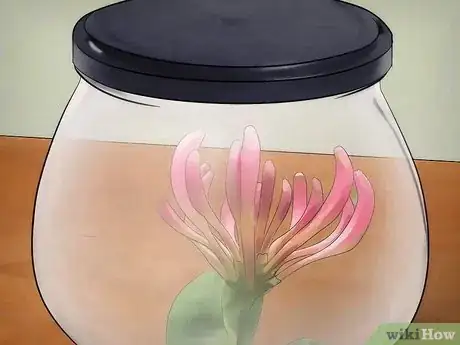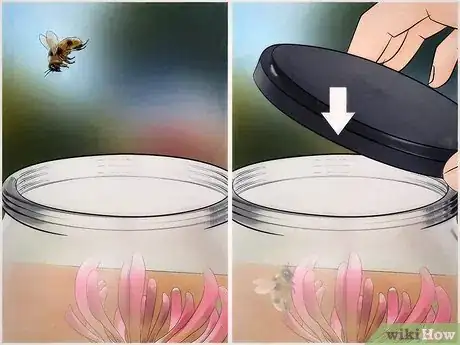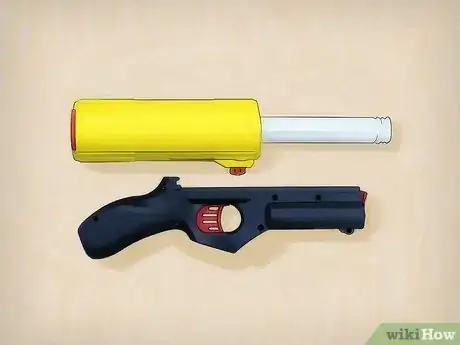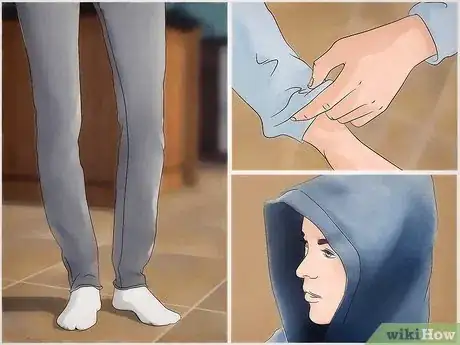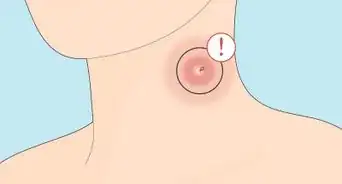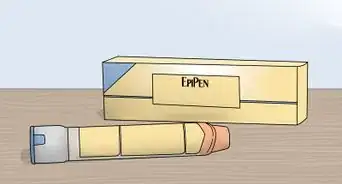This article was co-authored by Steve Downs. Steve Downs is a Live Honey Bee Removal Specialist, Honey bee Preservationist, and the Owner of Beecasso Live Bee Removal Inc, a licensed bee removal and relocation business based in the Los Angeles, California metro area. Steve has over 20 years of humane bee capturing and bee removal experience for both commercial and residential locations. Working with beekeepers, agriculturalists, and bee hobbyists, Steve sets up bee hives throughout the Los Angeles area and promotes the survival of bees. He has a passion for honeybee preservation and has created his own Beecasso sanctuary where rescued bee hives are relocated and preserved.
This article has been viewed 63,064 times.
Bees are lovely creatures with painful stingers. But sometimes we need to catch one of these lovely, yet dangerous creatures. Whether it be for a science fair project, to remove one from our home, or something else, catching a live bee is a potentially painful experience fraught with risk. However, there are a few things we can do to minimize our chance of getting stung while capturing a bee. Remember, though, whatever method you choose to use, you should keep a cool head and stay calm. Acting rashly or over-reacting might just get you stung!
Steps
Capturing the Bee with Flowers and Honey
-
1Dress appropriately. Before you even think about approaching the bee, you need to dress the part of a bee catcher. Of course not everyone’s going to have a bee catcher’s suit to protect themselves from getting stung. Instead, dress as best as you can. Cover up as much of your skin and face as you can. Consider:
- Wearing a long-sleeved hoodie. This will protect your neck, head, arms, and torso.
- Wear long pants. Jeans are probably the best, because they are the toughest and thickest.
- Try to layer when possible, bees can sting through clothing.[1]
-
2Get a large jar with a tapered neck. Now you’ve got to locate a large jar that you’ll later lure the bee into. Make sure it and its neck are large enough so the bee will be able to fly into it. Also make sure you’ve got something to cover or close the jar with once you’ve got the bee in it.Advertisement
-
3Gather some small flowers to put inside the jar. Get yourself some relatively small flowers to put in the jar to lure the bee. Your flowers will be the main bait to catch the bee. There are many types of flowers that will work, but there are a few that are especially good for attracting bees and other pollinators:
- Honeysuckle.
- Bee Balm.
- Lantana.[2]
-
4Spread some honey around the jar. Don’t use too much honey, and don’t use it in globs big enough to catch the bee. Just spread a little bit around the jar so that the bee will be even more attracted to it. If you are especially worried about hurting the bee, the best way to avoid that will be to put the honey underneath the flowers, so the bee will land on the flowers rather than the honey.[3]
-
5Watch for the bee and trap it at the right moment. You’ve got to stay diligent and watch to see when the bee flies into your trap. Once the bee has flown in, quickly put your top on the jar. Make sure that the top of the jar is securely on. You don’t want to get stung after all of this!
-
6Release the bee. Take your jar outside. Wait a couple minutes for the bee to settle down. Watch specifically for when the bee is investigating the flowers in the jar and not flying. At that moment, remove the top and retreat to a safe distance. Then wait for the bee to fly away!
- Once the bee is gone, close and remove the jar. You don’t want the bee or its friends coming back for more!
- Don’t run away. You might trip and hurt yourself. Just slowly walk away until you are a safe distance.
- Watch for where the bee went. This might give you a clue as to whether there is a beehive nearby. [4]
Using a Non-lethal Bug Vacuum
-
1Buy a non-lethal bug vacuum gun. There are a number of non-lethal bug vacuums on the market. They work by using suction to suck the bug—in this case a bee—into a chamber. Once the bug is in the chamber, you can close it off, remove it, and then release the bee outside. While this is a fairly effective method, remember that you’ll be going on the offensive, which will raise your chances of getting stung.
-
2Prepare your non-lethal bug vacuum. Make sure you’ve read your manual, have fresh batteries, and know how to work your bug vacuum. Make sure the release chamber is loaded and is flush with the rest of the gun—you don’t want your bee escaping and stinging you![5]
- Practice capturing a small piece of paper or a fly.
- Make sure you’re comfortable locking the chamber and taking it out. With most non-lethal bug vacuums, you shut the chamber and then turn off the suction. Know how to do this.
- Practice removing the capture chamber so that you can release the bee without getting stung.
-
3Dress for your encounter with the bee. Since you'll be required to get up close and personal with the bee, you'll have to cover yourself as best as you can to avoid getting stung. The more skin you cover, the less chances you'll have of getting stung if the bee decides to go after you.
- Find a sweat shirt or hoodie. Hoodie's are great because the hood will cover your neck, head, and your arms. Try to pick one that is relatively thick.
- Put on some long pants. You want to make sure your legs are covered, too.
- Wear goggles or glasses, if you’re extra nervous.
- Make sure to wear thick clothes. Bees often have no trouble stinging through clothing, so pick clothes that will protect you the best.[6]
-
4Approach the bee with your gun and capture it. After you’re dressed appropriately, approach the bee and use the suction to capture it. Since you’ve practiced, this should work like a charm. Most non-lethal bug vacuum guns have just enough power to capture the bee without hurting it. Remember, though, don’t get brave. Only approach the bee if you’re confident your gun will capture it.[7]
-
5Release the bee. Take the capture chamber out of the gun and wait a couple minutes for the bee to settle down. The key here is that you need to wait until the bee is standing still for a minute. After a few minutes, take it outside, sit it on a table, and crack the opening just a little bit. Walk away a few feet and wait until the bee leaves.[8]
Expert Q&A
-
QuestionCan you use your hands to catch a bee?
 Steve DownsSteve Downs is a Live Honey Bee Removal Specialist, Honey bee Preservationist, and the Owner of Beecasso Live Bee Removal Inc, a licensed bee removal and relocation business based in the Los Angeles, California metro area. Steve has over 20 years of humane bee capturing and bee removal experience for both commercial and residential locations. Working with beekeepers, agriculturalists, and bee hobbyists, Steve sets up bee hives throughout the Los Angeles area and promotes the survival of bees. He has a passion for honeybee preservation and has created his own Beecasso sanctuary where rescued bee hives are relocated and preserved.
Steve DownsSteve Downs is a Live Honey Bee Removal Specialist, Honey bee Preservationist, and the Owner of Beecasso Live Bee Removal Inc, a licensed bee removal and relocation business based in the Los Angeles, California metro area. Steve has over 20 years of humane bee capturing and bee removal experience for both commercial and residential locations. Working with beekeepers, agriculturalists, and bee hobbyists, Steve sets up bee hives throughout the Los Angeles area and promotes the survival of bees. He has a passion for honeybee preservation and has created his own Beecasso sanctuary where rescued bee hives are relocated and preserved.
Live Bee Removal Specialist Yes, but I would recommend wearing gloves for protection, and be very gentle so you don't get stung.
Yes, but I would recommend wearing gloves for protection, and be very gentle so you don't get stung.
References
- ↑ http://www.drgreene.com/tips-avoiding-bees-preventing-bee-stings/
- ↑ http://www.sunset.com/garden/flowers-plants/plants-pollination/plants-pollination_5
- ↑ http://www.bushfarms.com/beesferal.htm
- ↑ www.plantheroes.org/sites/.../CatchandReleaseInsectCollecting_0.pdf
- ↑ https://www.youtube.com/watch?v=K5UJTTqy2S4
- ↑ http://www.drgreene.com/tips-avoiding-bees-preventing-bee-stings/
- ↑ https://www.youtube.com/watch?v=K5UJTTqy2S4
- ↑ www.plantheroes.org/sites/.../CatchandReleaseInsectCollecting_0.pdf


